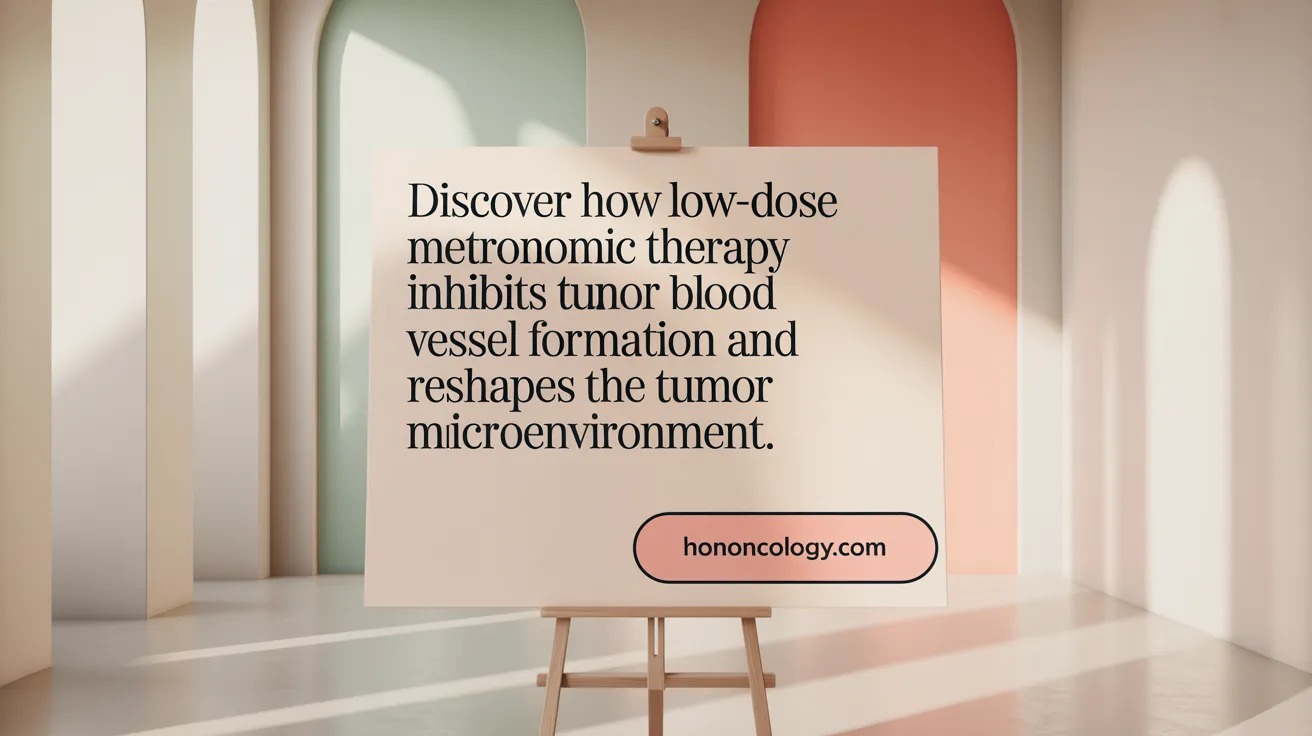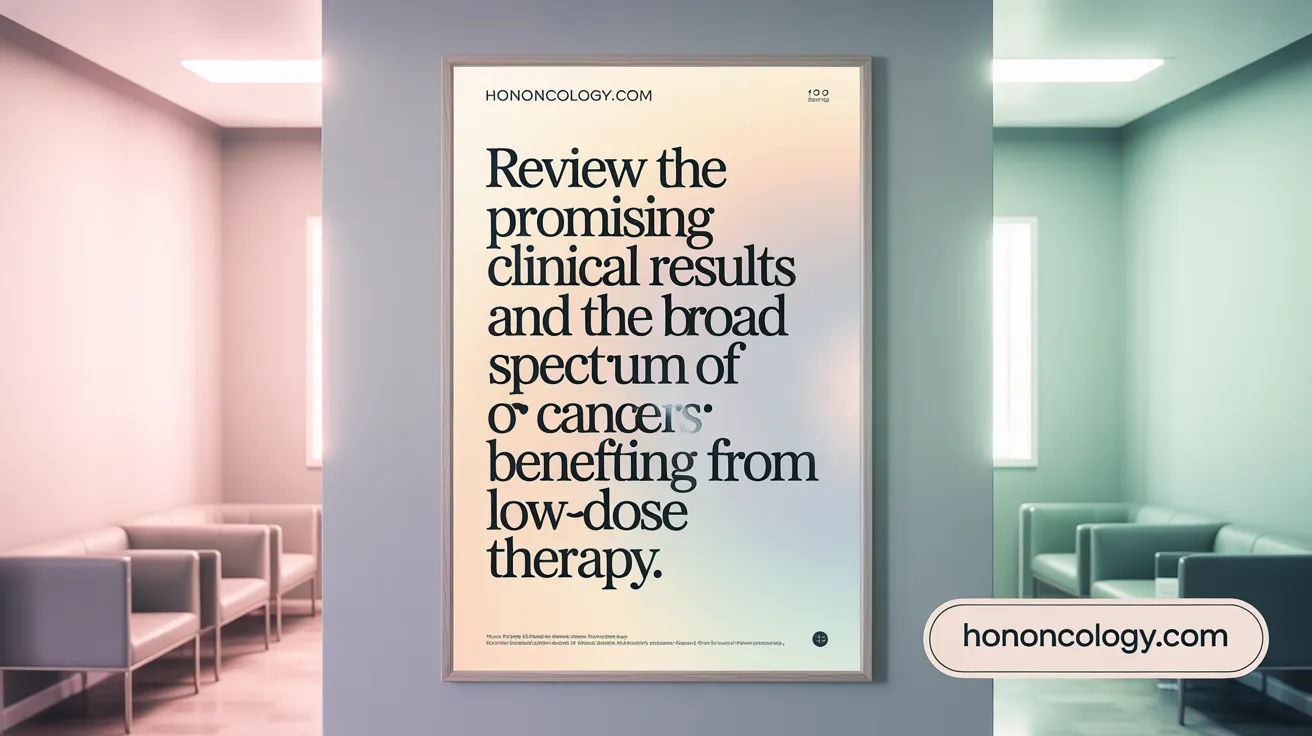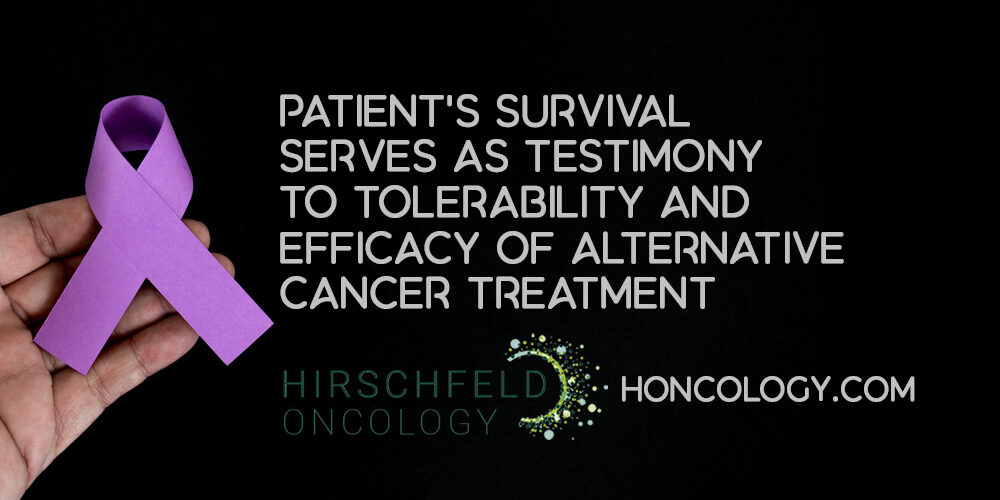Introduction to Low-Dose Multi-Drug Chemotherapy in Oncology
Overview of low-dose multi-drug chemotherapy
Low-dose multi-drug chemotherapy, often referred to as metronomic chemotherapy, is a treatment approach that administers chemotherapeutic agents continuously or frequently at doses significantly lower than the traditional maximum tolerated dose (MTD). Instead of using high doses with breaks, this strategy employs smaller, more frequent doses aimed at targeting tumor cells and the tumor microenvironment with reduced toxicity.
Context in modern cancer treatment
Within the evolving landscape of oncology, low-dose multi-drug chemotherapy offers an alternative or complement to standard therapies such as high-dose chemotherapy, targeted agents, and immunotherapy. It is especially valuable for patients who are elderly, frail, or have experienced adverse effects from conventional chemotherapy. Its role extends to maintenance therapy, aiming to sustain disease control while minimizing side effects and healthcare costs.
Principles of this alternative strategy
This chemotherapy regimen works predominantly by inhibiting tumor angiogenesis—the formation of new blood vessels that tumors require for growth—through effects on tumor endothelial cells and circulating endothelial progenitor cells. It also modulates the immune system by reducing immunosuppressive cell populations and enhancing anti-tumor immune responses. The principles emphasize continuous therapeutic pressure on cancer cells, reduced toxicity, and improved quality of life, often administered orally for convenience and prolonged exposure to drugs.
Understanding Metronomic Chemotherapy: Definition and Mechanisms
What is low-dose metronomic chemotherapy and how does it differ from traditional chemotherapy?
Metronomic chemotherapy is a treatment approach involving the continuous or frequent administration of conventional chemotherapeutic drugs at much lower doses than the traditional maximum tolerated dose (MTD) regimens. Unlike standard chemotherapy, which uses higher doses spaced by drug-free intervals to allow patient recovery, metronomic chemotherapy delivers drugs at steady, low levels without breaks.
Concept of metronomic chemotherapy
This strategy primarily aims to minimize the toxic side effects commonly associated with high-dose chemotherapy while maintaining anti-cancer effectiveness. It is especially beneficial for elderly or frail patients and those who cannot tolerate aggressive treatments. Instead of directly killing tumor cells with high toxicity, metronomic dosing targets the supportive tumor microenvironment, fostering tumor microenvironment normalization.
Anti-angiogenic mechanism
A prominent mode of action is the inhibition of tumor angiogenesis. Tumor growth depends on blood vessel formation. Metronomic chemotherapy affects the tumor vasculature by selectively targeting activated endothelial cells and circulating endothelial progenitor cells at very low drug concentrations. This suppresses new blood vessel growth, starving the tumor of nutrients and oxygen.
Metronomic therapy shifts the balance within the tumor microenvironment by increasing endogenous angiogenesis inhibitors like thrombospondin-1 and decreasing pro-angiogenic factors such as vascular endothelial growth factor (VEGF). This leads to tumor vessel normalization and dormancy (anti-angiogenic effects).
Immunomodulatory effects
In addition to anti-angiogenesis, metronomic chemotherapy modulates the immune system. It depletes immunosuppressive cells like regulatory T cells (Tregs) and myeloid-derived suppressor cells, enhancing the maturation and activity of dendritic cells. This immune stimulation facilitates tumor antigen recognition and promotes an anti-tumor immune response, potentially inducing immunogenic cell death.
Together, these mechanisms render metronomic chemotherapy a multi-targeted, less toxic alternative to traditional chemotherapy, with promising applications in long-term maintenance therapy and combination regimens, including combination of metronomic chemotherapy and immunotherapy.
Advantages of Low-Dose Multi-Drug Chemotherapy in Cancer Care

What are the advantages of low-dose multi-drug chemotherapy compared to conventional high dose chemotherapy?
Low-dose multi-drug chemotherapy, commonly known as metronomic chemotherapy, provides several benefits over traditional high-dose regimens. One major advantage is the significant reduction in treatment-related toxicity. Unlike high-dose chemotherapy, which often causes severe side effects like myelosuppression, hair loss, nausea, and fatigue, low-dose schedules result in fewer and milder adverse events, such as mostly grade 1-2 toxicities including leukopenia and nausea. This gentler toxicity profile helps patients avoid debilitating symptoms commonly associated with conventional chemotherapy.
Additionally, this approach improves patients' quality of life. Because treatments are less harsh, patients experience less physical and emotional stress, allowing them to maintain daily activities and better tolerate prolonged therapy. Low-dose regimens are particularly beneficial for elderly or frail patients who are more vulnerable to the intense effects of high-dose chemotherapy and often cannot tolerate standard treatment protocols.
Cost-effectiveness is another important advantage. Many low-dose protocols use oral medications, which reduce the need for hospital visits and intravenous administration costs. Oral delivery provides flexibility, enabling patients to take medications at home over extended periods, which is especially supportive for maintenance therapy and long-term cancer control.
Overall, low-dose multi-drug chemotherapy offers a balance of effective tumor management with improved safety and patient comfort, making it a pragmatic alternative or adjunct to traditional high-dose treatment strategies.
Mechanistic Insights: Targeting Tumor Microenvironment and Angiogenesis

How does low-dose chemotherapy impact the tumor microenvironment and angiogenesis?
Low-dose chemotherapy, often referred to as metronomic chemotherapy, works uniquely compared to traditional high-dose regimens by focusing on the tumor microenvironment normalization, particularly its vasculature. It exerts a strong anti-angiogenic effect primarily through continuous, low-dose administration that targets the endothelial cells lining tumor blood vessels.
Effects on tumor vasculature and endothelial cells
This treatment selectively inhibits proliferation and induces apoptosis in activated tumor endothelial cells, which are essential for new blood vessel formation that supports tumor growth. By targeting these cells at low drug concentrations, it spares normal tissues and reduces systemic toxicity. This mechanism is well described under the mechanisms of metronomic chemotherapy, highlighting the inhibition of tumor angiogenesis and effects on tumor endothelial cells.
Inhibition of circulating endothelial progenitor cells
Metronomic chemotherapy also decreases the number and activity of circulating endothelial progenitor cells (CEPs), cells important for vascular repair and angiogenesis. This inhibition further reduces the tumor's ability to sustain and remodel its blood supply, as reviewed in studies on inhibiting tumor angiogenesis and reducing circulating endothelial progenitor cells.
Balance of pro- and anti-angiogenic factors to normalize vasculature
The therapy modulates the angiogenic balance within the tumor microenvironment by increasing endogenous angiogenesis inhibitors such as thrombospondin-1 and lowering pro-angiogenic mediators like vascular endothelial growth factor (VEGF). This shift helps normalize tumor blood vessels, improving their structure and function. This concept of balancing angiogenic factors and tumour blood vessel normalization is key to enhancing therapy delivery and immune cell infiltration.
Normalized vasculature enhances delivery of therapeutic agents and facilitates immune cell infiltration, thereby bolstering anti-tumor effects beyond direct cytotoxicity. This multifaceted approach reduces tumor progression with fewer side effects, making it especially suitable for long-term use in vulnerable patient populations, as reported in advantages of metronomic chemotherapy and LDM chemotherapy safety profile.
Immunomodulatory Effects: Enhancing Anti-Tumor Immune Response

What are the immunomodulatory effects of low-dose chemotherapy?
Low-dose chemotherapy, also known as metronomic chemotherapy, goes beyond directly targeting tumor cells and blood vessels; it significantly modulates the immune system to fight cancer more effectively. One major action is the reduction of regulatory T cells (Tregs) and other immunosuppressive populations such as myeloid-derived suppressor cells (MDSCs). These cells normally inhibit the immune system's ability to attack tumors, so their depletion helps unleash stronger anti-tumor immunity (Mechanisms of metronomic chemotherapy, LDM chemotherapy for elderly and frail patients).
The therapy also promotes dendritic cell maturation. Mature dendritic cells are key for presenting cancer antigens to T cells, which helps activate cytotoxic T lymphocytes that specifically kill tumor cells. By enhancing this antigen presentation, low-dose chemotherapy improves the body's ability to recognize and target cancer (Immunomodulatory effects in LDM chemotherapy, Immunomodulation in metronomic therapy).
Moreover, low-dose chemotherapy can induce immunogenic cell death. This process releases danger signals and tumor antigens that can further stimulate immune responses against cancer. Together, these immune-modulating effects help convert the tumor microenvironment from immunosuppressive to immunostimulatory, supporting long-term tumor control (Anti-angiogenic effects of LDM therapy, tumor microenvironment normalization.
Through these mechanisms—depleting suppressive immune cells, improving antigen presentation, and triggering immunogenic death—low-dose chemotherapy effectively enhances the body's natural anti-tumor immune response as part of its multi-faceted therapeutic activity (Immunomodulation in metronomic therapy, Mechanisms of metronomic chemotherapy).
Clinical Evidence and Applications: Efficacy in Various Cancer Types

What clinical evidence supports the use of low-dose multi-drug chemotherapy?
Low-dose metronomic chemotherapy (LDMC) is increasingly supported by clinical evidence for its effectiveness across several cancer types. Studies have demonstrated disease control rates (DCR) averaging around 26%, with progression-free survival (PFS) similar to conventional chemotherapy. For example, in metastatic breast cancer, LDMC achieved a DCR of 30%, comparable to 22.5% with standard treatments, with a median PFS of about 12 weeks in both groups (Low-dose metronomic chemotherapy overview, Low-dose metronomic chemotherapy.
LDMC has also shown promise in ovarian and prostate cancers, where it stabilizes disease and offers sustained control with fewer toxicities. This makes it particularly suitable for the elderly and frail who may not tolerate intensive chemotherapy well (Metronomic chemotherapy advantages, LDM chemotherapy for elderly and frail patients.
Of note, triple-negative breast cancer (TNBC) patients may derive notable benefit from LDMC. Some studies indicate a higher DCR in TNBC compared to conventional chemotherapy, suggesting it as a viable option where treatment options are limited (LDMC benefits in triple-negative breast cancer.
In pediatric oncology, metronomic regimens have been explored for relapsed or refractory solid tumors, showing potential in improving progression-free survival and quality of life with manageable side effects (Pediatric solid tumors and metronomic chemotherapy). The cumulative evidence underscores LDMC as an efficacious, tolerable cancer therapy that balances disease control with patient quality of life, especially in sensitive populations (Metronomic chemotherapy overview, Low-dose metronomic chemotherapy safety profile.
Comparison with Conventional Chemotherapy: Efficacy and Safety Profiles
How does the efficacy and safety of low-dose chemotherapy compare to high-dose regimens?
Low-dose chemotherapy, also called metronomic chemotherapy, has shown comparable efficacy to traditional high-dose chemotherapy in several cancer types. Studies in metastatic breast cancer patients demonstrate similar progression-free survival periods — often around 12 weeks — and comparable disease control rates. For example, disease control rates near 30% have been reported with low-dose regimens, matching or even exceeding those of high-dose treatments in some subgroups like triple-negative breast cancer (Metronomic chemotherapy overview, LDMC benefits in triple-negative breast cancer.
Importantly, low-dose chemotherapy regimens yield a markedly improved safety profile. Patients experience fewer and generally milder side effects, including reduced incidence of severe toxicities such as anemia and fatigue. Common adverse events tend to be limited to mild leukopenia, nausea, and gastric discomfort, with serious grade 3 or 4 toxicities being rare (toxicity profile of LDMC, Reduced toxicity in chemotherapy.
This reduction in toxic side effects makes low-dose chemotherapy especially suitable for elderly, frail, or pretreated patients who might not tolerate conventional high-dose chemotherapy (LDM chemotherapy for elderly and frail patients, Suitability for elderly patients. Additionally, the better tolerability supports its use in long-term maintenance therapy, where sustained disease control is desired without compromising quality of life (Long-term maintenance therapy.
Overall, low-dose chemotherapy balances effective cancer control with a safer, more manageable toxicity profile, offering a valuable alternative for patients requiring chronic treatment or those for whom aggressive therapy presents high risks (Low dose vs high dose chemotherapy outcomes, Metronomic chemotherapy benefits).
Integration with Other Cancer Therapies: Combination and Sequencing Strategies
Can low-dose chemotherapy be combined with other cancer treatments?
Yes, low-dose chemotherapy, particularly metronomic chemotherapy, is frequently combined with other cancer treatments such as immunotherapy, targeted therapies, and conventional chemotherapy. This combination approach leverages the unique mechanisms of low-dose regimens — notably anti-angiogenic effects and immunomodulation — to complement and enhance the action of other therapies (combination of metronomic chemotherapy and immunotherapy.
Combining low-dose chemotherapy with immunotherapy and targeted agents
Low-dose chemotherapy can potentiate immune responses by reducing immunosuppressive cells like regulatory T cells and myeloid-derived suppressor cells, thereby boosting the efficacy of immunotherapies such as checkpoint inhibitors. When paired with targeted agents focused on tumor-specific molecules, the continuous vascular normalization induced by metronomic dosing can improve drug delivery and bolster tumor control (Metronomic therapy. Clinical trials and preclinical models show promise in reducing toxicities through lower dosing while sustaining or improving treatment outcomes (Low Dose Chemotherapy and Immunotherapy).
Role in maintenance therapy and modulation of tumor microenvironment
The sustained administration of low-dose chemotherapy lends itself well to maintenance therapy. It helps stabilize disease progression by continuously suppressing tumor angiogenesis and modulating the tumor microenvironment normalization. This strategy discourages tumor regrowth and metastasis by rebalancing pro- and anti-angiogenic factors and enhancing anti-tumor immune responses, which can improve long-term disease control (Metronomic chemotherapy overview.
Potential to reduce resistance and improve outcomes
Low-dose chemotherapy targets genetically stable endothelial cells in tumor blood vessels, decreasing the risk of resistance that commonly occurs with high-dose regimens targeting cancer cells directly. By integrating metronomic treatment with other modalities, it is possible to circumvent tumor escape mechanisms and maintain therapeutic effectiveness (Mechanisms of metronomic chemotherapy. This integrative strategy shows clinical benefits, particularly for frail patients or those with advanced cancers, by enhancing response rates and prolonging progression-free survival with reduced toxicity (Low-dose metronomic chemotherapy benefits.
Table: Advantages of Combining Low-Dose Chemotherapy with Other Treatments
| Combination Partner | Benefits | Mechanistic Insights |
|---|---|---|
| Immunotherapy | Enhanced immune activation, synergy | Immunomodulation, Treg reduction (Immunomodulatory effects |
| Targeted Therapy | Improved drug delivery and tumor control | Vascular normalization and anti-angiogenesis (Targeted therapy and vascular normalization) |
| Conventional Chemotherapy | Reduced toxicity, sustained disease control | Continuous cytotoxic and microenvironmental targeting (Combination strategies |
Overall, integrating low-dose chemotherapy within combination or sequencing regimens is a promising approach that supports enhanced efficacy, better tolerability, and sustainable disease management (Low-dose chemotherapy regimen overview).
Pharmacological and Biological Considerations in Treatment Planning
What pharmacological factors influence low-dose chemotherapy treatment planning?
Low-dose chemotherapy, often administered as metronomic chemotherapy, emphasizes frequent and continuous dosing rather than relying on high dose intensity. This approach seeks to maintain steady therapeutic pressure on tumor cells and the tumor microenvironment normalization while reducing toxic side effects common with traditional maximum tolerated dose (MTD) chemotherapy.
An essential pharmacological factor is the scheduling and frequency of drug administration. Studies have shown that keeping treatment intervals shorter than 40% of the tumor recovery time helps prevent cancer relapse and supports sustained tumor control. This frequent dosing helps inhibit angiogenesis and promote immune modulation effectively as part of the mechanisms of metronomic chemotherapy.
Biomarkers play a crucial role in guiding treatment planning. Circulating endothelial progenitor cells (CEPs), vascular endothelial growth factor (VEGF), and other angiogenesis-related markers serve as surrogates to optimize biologic dosing. Monitoring these parameters helps clinicians adjust drug doses to maintain anti-angiogenic effects without increasing toxicity, reflecting best practices in monitoring optimal biologic dose and angiogenesis inhibition.
Personalized dosing strategies are increasingly important. Patients vary in their ability to tolerate treatment and in tumor biology. Tailoring doses and treatment schedules based on patient-specific factors and biomarker feedback helps maximize therapeutic efficacy while minimizing adverse effects. This approach supports the extended use of metronomic chemotherapy, especially in elderly or frail patients, consistent with findings on dose and interval strategies and patient selection in low-dose metronomic chemotherapy and pharmacogenetic tailoring in chemotherapy.
Overall, pharmacological considerations in low-dose chemotherapy focus on balancing dose frequency with biological response and individual patient needs to enhance safety and treatment outcomes, embodying key principles in metronomic chemotherapy dosing and optimization.
Current Challenges and Ongoing Research in Low-Dose Chemotherapy

What are the challenges and research directions for low-dose multi-drug chemotherapy?
Low-dose metronomic chemotherapy (LDM) shows promise due to its reduced toxicity and ability to modulate the tumor microenvironment, but several challenges remain before it can become a mainstream treatment approach.
Firstly, there is a lack of extensive phase III clinical trials providing definitive evidence of its efficacy compared to conventional maximum tolerated dose (MTD) regimens. Many studies have been phase II or smaller scale, often involving pretreated or advanced cancer patients. This limited data makes it difficult to firmly establish LDM's role in standard practice.
Secondly, optimal drug selection, combinations, and dosing schedules are still largely empirical. While cyclophosphamide is commonly used, and combinations with methotrexate and other agents appear beneficial, there is no consensus on the best agents or doses. Determining which patient subgroups are most likely to benefit also remains an open question, complicating treatment personalization through pharmacogenetic tailoring in chemotherapy.
Resistance to LDM chemotherapy, while less frequent than with traditional chemotherapy due to its anti-angiogenic and immunomodulatory mechanisms targeting genetically stable endothelial cells, can still occur. Understanding and overcoming mechanisms like vascular escape or intrinsic tumor tolerance is an active area of research.
Current investigations focus on refining LDM regimens by integrating pharmacogenetic and pharmacoproteomic data to tailor therapies to individual molecular tumor profiles. Additionally, combining LDM with immunotherapies or targeted agents shows potential to enhance efficacy and overcome resistance.
In summary, ongoing research aims to optimize low-dose chemotherapy through well-designed clinical trials, precision medicine approaches, and novel combination strategies to maximize benefits and broaden its clinical applicability.
Quality of Life and Patient-Centered Benefits of Low-Dose Regimens
How does low-dose chemotherapy improve quality of life for cancer patients?
Low-dose chemotherapy, administered in smaller, more frequent doses, offers a gentler alternative to traditional high-dose treatments. By significantly reducing common and debilitating side effects such as fatigue, nausea, hair loss, and immune suppression, patients can better maintain their usual daily activities and overall functioning (Low Dose Chemotherapy Overview, Metronomic chemotherapy benefits, Low-dose chemotherapy regimen overview.
This approach also enhances treatment flexibility. Many low-dose chemotherapy regimens utilize oral medications that patients can take at home, decreasing the need for frequent hospital visits and allowing for more comfortable, long-term outpatient care (Low-dose metronomic chemotherapy, Low-dose chemotherapy regimen overview. Treatment sessions tend to be shorter and less disruptive, further supporting patients' independence and lifestyle.
Alongside chemotherapy, integrative supportive care in cancer treatment—such as nutritional support, acupuncture, massage, and mind-body techniques—are often incorporated. These interventions help manage symptoms, reduce stress, and improve emotional well-being, working in synergy with low-dose chemotherapy to enhance overall quality of life (Alternative cancer treatments, Integrative supportive care in cancer treatment).
Together, these patient-centered benefits make low-dose chemotherapy a viable and appealing option, especially for elderly or frail patients, or those seeking to minimize treatment burden while maintaining efficacy (Low-dose metronomic chemotherapy advantages, Reduced toxicity in chemotherapy, Low-dose metronomic chemotherapy safety profile.
Emerging Technologies and Personalized Approaches in Oncology Treatment
How do emerging oncology technologies influence the role of low-dose chemotherapy?
Recent advances in precision medicine and immunotherapy have transformed cancer treatment by enabling personalized therapy plans tailored to the genetic and molecular makeup of each tumor. These breakthroughs empower clinicians to effectively integrate low-dose chemotherapy within broader, multi-modal strategies.
Precision oncology leverages detailed genomic profiling to identify specific mutations and biomarkers that guide the selection and optimization of therapies. Low-dose, metronomic chemotherapy can be customized according to these molecular insights, improving its efficacy and reducing side effects. This personalization is further enhanced by AI-powered tools that analyze vast clinical and molecular data sets to predict tumor response and optimal dosing schedules.
Biomarker-driven monitoring, such as tracking circulating endothelial progenitor cells or tumor DNA, allows real-time adjustment of drug regimens, ensuring continuous therapeutic pressure on cancer cells while minimizing toxicity. When combined with immunotherapy, low-dose chemotherapy can modulate the tumor microenvironment normalization, enhancing immune activation and angiogenesis inhibition for synergistic antitumor effects (Metronomic chemotherapy overview.
Looking forward, the fusion of low-dose chemotherapy with novel targeted agents, including monoclonal antibodies, antibody-drug conjugates, and small molecule inhibitors, promises a new frontier in oncology. These combinations seek to maximize tumor control by attacking cancer cells through complementary mechanisms while preserving patient quality of life.
In summary, emerging technologies and personalized treatment frameworks are expanding the scope and effectiveness of low-dose chemotherapy as a vital component of modern cancer care.
Conclusion: The Future of Low-Dose Multi-Drug Chemotherapy in Cancer Care
Overview of Therapeutic Benefits and Evidence
Low-dose multi-drug chemotherapy (LDM chemo) offers a compelling alternative to traditional high-dose chemotherapy. It achieves tumor control through continuous, low-dose administration, targeting tumor blood vessels and modulating the immune system. This approach reduces severe side effects, making it especially beneficial for elderly, frail, or pretreated patients. Studies demonstrate comparable progression-free survival and disease control rates to conventional chemotherapy, with often improved tolerance and quality of life.
Integration into Personalized Oncology
LDM chemotherapy is poised to integrate seamlessly with precision oncology. By combining multiple drugs at optimized low doses, it can complement targeted therapies, immunotherapies, and other novel agents. Its anti-angiogenic and immunomodulatory effects may enhance responses in complex tumor microenvironments, enabling individualized regimens based on tumor biology and patient factors.
The Need for Ongoing Research
Despite promising early data, further large-scale, randomized trials are essential to identify optimal drug combinations, dosing schedules, biomarkers for response, and patient selection criteria. Continued pharmacogenetic and clinical research will help refine its use, ensuring maximum efficacy with minimal toxicity. As research advances, low-dose multi-drug chemotherapy is likely to become a cornerstone in holistic, personalized cancer care strategies.





.png)


.png)
.png)




